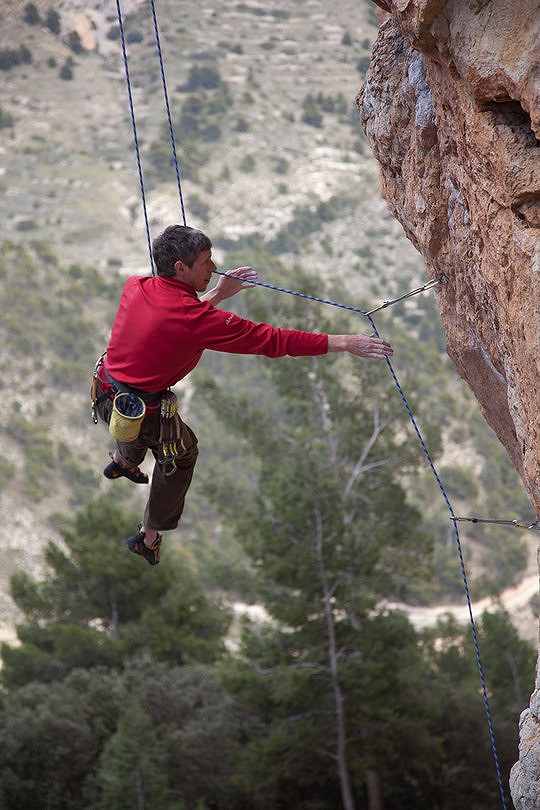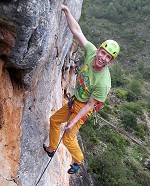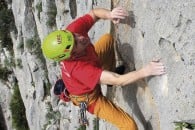
UKClimbing and Rockfax Director Alan James makes the case for omitting specific route length information from route descriptions of sport routes in guidebooks.
Back in 2009, when we published the France: Haute Provence Rockfax guide, we took the decision to remove route lengths from the descriptions of single pitch sport routes in our guidebooks. Since then all Rockfax guidebooks have followed this policy. We do include individual pitch lengths for multi-pitch routes where we know them, but the lengths of all single pitch routes are now indicated more generally by spot height markers on the topos. These are coloured yellow up to 29m and red for heights of 30m and above. We also include spot heights up most multi-pitch routes and on abseil descents.
The reason for this is simply because we don't feel that it is possible to provide accurate route lengths and, when combined with other external factors, the provision of this information can lead to dangerous practice by some climbers.
To start with, actually measuring route lengths is an extremely difficult procedure and to do it accurately for thousands of routes in the areas covered by our books is almost impossible.
When trad climbing on double 50m or 60m ropes this isn't such an issue. Most climbers wouldn't even notice as much as 10m extra on a 30m pitch. Historically most UK guidebooks have either over-estimated pitch lengths, or put little effort into actually checking them, especially the older ones covering mountain routes. If you take a look you can find examples of people abseiling routes with guidebook lengths in excess of 120m on 60m ropes or running together two guidebook '45m pitches' on a 50m rope! This just indicates how the accuracy of the pitch lengths when trad climbing is relatively unimportant - so much so that no-one has really taken it particularly seriously over the years.
When sport climbing it is a different matter. It is crucial to get these lengths as accurate as possible, since people lower-off routes that can often use the full length of a 50m, 60m or 70m rope, with obvious consequences should you get it wrong and run out of rope before reaching the ground: the rope runs through the belay device and the climber falls to the floor. This is especially important on routes at around the 30m length, since the most popular rope length is 60m.
If we write 30m in a route description in a guidebook we make several assumptions.
- Firstly, we assume that we have measured it correctly and, as mentioned above, it isn't possible to be 100% certain of this when putting together information for 2000 routes.
- Secondly, we need to know exactly how long our rope is. In brief tests we measured several 60m ropes and got lengths varying from 60m to 66m. Curiously there is no standard in the trade. It is assumed that a 60m rope is at least 60m, but beyond that there is no requirement for how much extra you give and some rope manufacturers are more generous than others (although I would suggest that they aren't actually being generous so much as lazy). We can check our ropes if we are using them to measure routes - but do you check yours? If you climb for years on a 66m rope that you think is only 60m, it might give you a slightly distorted impression of what a guidebook 30m route actually is. Then when you get a new 60m rope that is really 60m, you could end up making a serious miscalculation.
- Thirdly, where do you measure from? The base of routes can be rough and rugged and you can stand in different places to belay. If you stand a bit lower down, then suddenly a 30m route might be 35m to you. As guidebook writers we can't prescribe standing positions for each route we measure.
- Fourthly, routes are often rebolted, which can lead to them being lengthened if the belay is moved up or the actual line of the bolts changed. In this case, the presence of a route length in a guidebook becomes dangerous, since it is wrong and a wrong route length is much worse than no route length.
There are many other factors that can use up different amounts of rope. Some people tie big bulky knots with long tails using an extra metre or so. Some people clip bolts on adjacent routes, which lengthens the overall route. Some people chop the tatty ends off their ropes but then aren't sure how much they chop off or even forget that they have done so.
With all these factors in mind, the main impression you get is that you should be very careful to make your own judgement when lowering off routes and always tie a knot in the other end in case things go wrong, so that you can't be actually dropped by your belayer. This is what most climbers do and accidents are rare - but they do still happen.
If you read '30m' in a guidebook you may think that this is only a guideline and that you need to be careful. But on the 6th route of the day, having lowered off everything else at the crag, you can get blasé. Check the length and go for it without thinking based on the 30m in the guidebook. The factors described above then come into play. Is your belayer standing in the right place? Has the route been rebolted? Was the route actually 30m in the first place or 33m because the person who measured it had a long '60m' rope? Suddenly when lowering you are 6m up off the deck as your rope end flies through the belayer's hands...

If you don't set off up a route with someone else's pre-conceived idea of exactly how long it is then you are much more likely to make your own decision. Basically, you have to assess each route on what is in front of you. A guidebook can nudge you in the right direction by including spot heights on the topo, but it still leaves the final decision to you.
So our policy for Rockfax guidebooks is not to include route lengths on the grounds that we don't think we can provide sport route lengths accurate enough for people to rely on due to factors out of our control. We think that other guidebooks should consider dropping this information as well to put the emphasis back onto climbers making their own decisions.
And even then, always tie a knot in the other end!

- DESTINATION GUIDE: Finest Lower Grade Routes in Pembroke 27 Aug
- DESTINATION GUIDE: The Best of Peak Limestone Sport Climbing (6a – 7a) 9 Jan, 2024
- REVIEW: Dolomite Crodarossa Hi GTX Boot 21 Jun, 2022
- REVIEW: Scarpa Gecko Approach Shoe 11 Jan, 2022
- REVIEW: Red Chili Mystix 16 Jul, 2021
- PHOTOGRAPHY: Three Generations on Wall End Slab 12 Jul, 2021
- REVIEW: Arc'teryx Creston Pant 25 Sep, 2020
- VIDEO: Removing Loose Rock at Horseshoe 20 Jul, 2020
- REVIEW: Montane Protium Pull-on 16 Jun, 2020
- REVIEW: Lowe Alpine Rogue 48 5 Jun, 2020


















Comments
There is another slight complication - in Kalymnos and other areas too presumably. In general the route lengths given in the current guide and sometimes written on the rock are on the generous side - but not always - occasionally they are underestimates - not helpful.
Chris
Even if they're not underestimates, if people get used to being ok on "40 metre" routes with 70 metre ropes, they can be unpleasantly surprised when they're suddenly not quite so ok.
for single pitch stuff like this the only thing needed is the range of route heights for a crag, e.g. routs between 15 - 35m; also shown in the crag overview. The rest is nice-to-haves if the writer is happy with the veracity of the info.
I need to be able to quickly review and discard the crags that aren't appropriate, or have little to offer, in relation to the length I'v got. Of rope; length of rope!
this article seems to make a protracted palaver about something that doesn't need to be protracted or palavered. The length of my equipment is for me to know and is my concern; I just need to know where I best put it to use enjoying myself.... ahem.
I'm not really a sport climber, but regarding trad routes I do think that having a pitch length is useful (though yes it is only a rough guide and that's understood). Thus -- for trad -- the Rockfax trend towards not giving lengths is mildly irritating; it's just one of the bits of info I'm used to and expect.
My thoughts too; mind turned to Hamlet: "The lady doth protest too much, methinks"